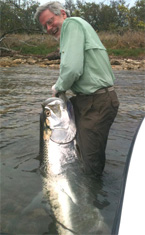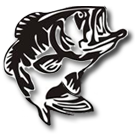 Let's learn a little about this majestic fish.
Tarpon (Megalops) is considered one of the great saltwater game fishes. They are prized not only because of their great size, but also because of the fight they put up and their spectacular leaping ability. They are bony fish and their meat is not desirable, so most are released after they are caught.
One of the unique features of tarpon is their swim bladder, which functions as a respiratory pseudo-organ. These gas structures can be used for buoyancy, as an accessory respiratory organ, or both. These fish are obligate air breathers, and if they are not allowed to access the surface, they will die. The exchange of gas occurs at the surface through a rolling motion that is commonly associated with tarpon sightings. This "breathing" is believed to be mediated by visual cues, and the frequency of breathing is inversely correlated to the dissolved O2 content of the water in which they live.
Tarpon grow to about 4–8 ft long and weigh 60–280 lbs. They have dorsal and anal soft rays and have bluish or greenish backs. Tarpons possess distinctive lateral lines and have shiny, silvery scales that cover most of their bodies, excluding the head. They have large eyes with adipose eyelids and broad mouths with prominent lower jaws that jut out farther than the rest of the face.
Let's learn a little about this majestic fish.
Tarpon (Megalops) is considered one of the great saltwater game fishes. They are prized not only because of their great size, but also because of the fight they put up and their spectacular leaping ability. They are bony fish and their meat is not desirable, so most are released after they are caught.
One of the unique features of tarpon is their swim bladder, which functions as a respiratory pseudo-organ. These gas structures can be used for buoyancy, as an accessory respiratory organ, or both. These fish are obligate air breathers, and if they are not allowed to access the surface, they will die. The exchange of gas occurs at the surface through a rolling motion that is commonly associated with tarpon sightings. This "breathing" is believed to be mediated by visual cues, and the frequency of breathing is inversely correlated to the dissolved O2 content of the water in which they live.
Tarpon grow to about 4–8 ft long and weigh 60–280 lbs. They have dorsal and anal soft rays and have bluish or greenish backs. Tarpons possess distinctive lateral lines and have shiny, silvery scales that cover most of their bodies, excluding the head. They have large eyes with adipose eyelids and broad mouths with prominent lower jaws that jut out farther than the rest of the face.
 Now let's get one on the line!
Primarily inshore fish, preferring shallow estuaries around mangrove forests, salt marshes or hard-bottom/seagrass communities of the Keys. Tarpon tolerate a wide salinity range, and as juveniles, enter fresh waters.
The tarpon visit the Middle Florida Keys each spring to hang out at bridge passes. The Bahia Honda Bridges is very prolific for tarpon fishing because tides are not a concern as they would be else where. You can fish these waters all hours of the day, even into the evening hours.
Tarpon are scavengers and will eat just about anything. Despite their large size, they feed on surprisingly small organisms, including mullet, ladyfish, pinfish, grunts, crabs, threadfin herring, scaled sardines and even catfish. The fish normally travel in pods, sometimes up to 100 or more. Small groups are often observed swimming in circles, or "daisy chaining," which is a courtship ritual.
Live bait tarpon fishing is done in the shadow of the Bahia Honda bridge. The Bahia Honda bridge offers one of the Keys most picturesque backgrounds as well as sheltered waters.
If you enjoy doing battle with really large and powerful fish, this is a perfect opportunity. Tarpon are hard fighting. You have to work hard at getting them to the boat, but the fight is well worth the sore arms.
Now let's get one on the line!
Primarily inshore fish, preferring shallow estuaries around mangrove forests, salt marshes or hard-bottom/seagrass communities of the Keys. Tarpon tolerate a wide salinity range, and as juveniles, enter fresh waters.
The tarpon visit the Middle Florida Keys each spring to hang out at bridge passes. The Bahia Honda Bridges is very prolific for tarpon fishing because tides are not a concern as they would be else where. You can fish these waters all hours of the day, even into the evening hours.
Tarpon are scavengers and will eat just about anything. Despite their large size, they feed on surprisingly small organisms, including mullet, ladyfish, pinfish, grunts, crabs, threadfin herring, scaled sardines and even catfish. The fish normally travel in pods, sometimes up to 100 or more. Small groups are often observed swimming in circles, or "daisy chaining," which is a courtship ritual.
Live bait tarpon fishing is done in the shadow of the Bahia Honda bridge. The Bahia Honda bridge offers one of the Keys most picturesque backgrounds as well as sheltered waters.
If you enjoy doing battle with really large and powerful fish, this is a perfect opportunity. Tarpon are hard fighting. You have to work hard at getting them to the boat, but the fight is well worth the sore arms.
© Mark King - All Rights Reserved
Design by East Coast Computer Solutions
Design by East Coast Computer Solutions






